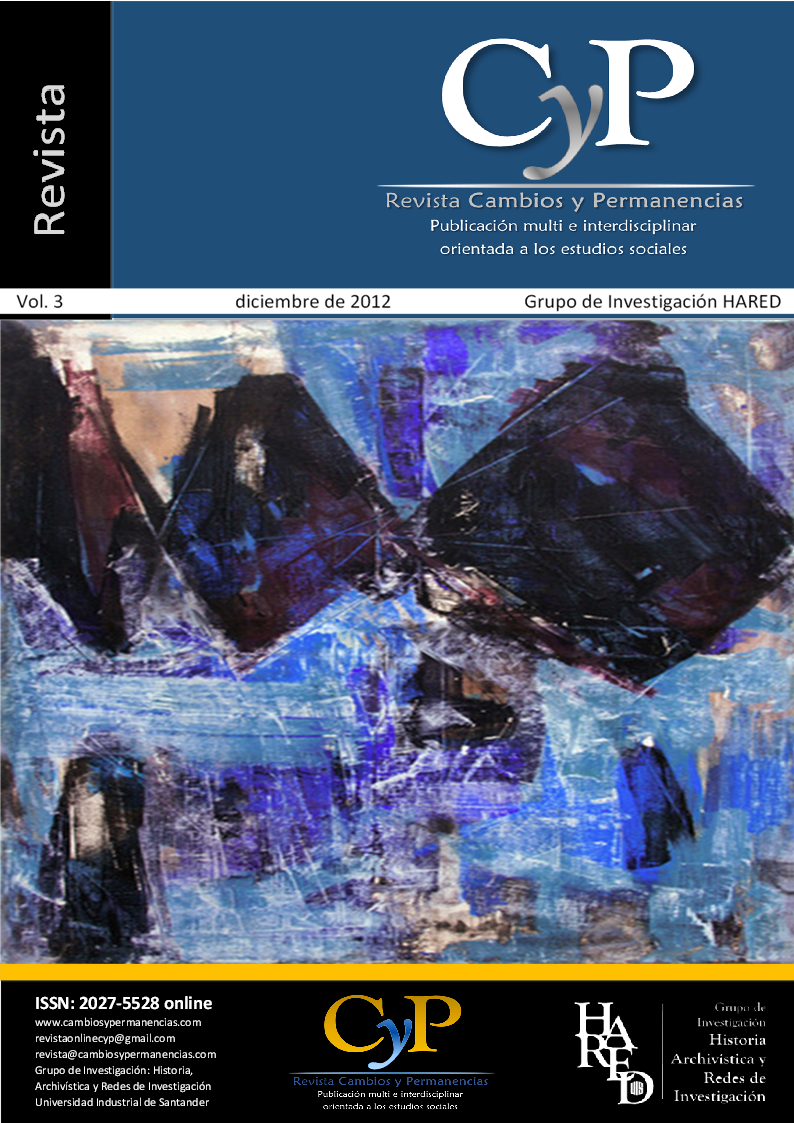CULTURAL REGULATION BY MEANS OF THE TECHNOLOGICAL ACCEPTANCE IN A TECHNO-SOCIAL ENVIRONMENT
Keywords
- Culture,
- ICT,
- e-Government,
- G2C,
- technological acceptance
- techno-social environment ...More
How to Cite
Abstract
Currently in Colombia, the programs developed to facilitate citizens appropriation of the Information and Communication Technologies (ICT) concentrate efforts on to increasing and to improving the ICT infrastructure (hardware-software). This tendency might be observed in the results presented by the government about ICT politics which register the number of given computers, the increase on information transmission/reception speed or the number of Internet connections enabled in the country, among others. However, the access to the Information Society, the knowledge construction and the development of cognitive processes result to be non reachable complex phases with just having more technology. This work proposes the consideration of variables linked to the cultural environment of the regions and the knowledge of its relationships, with the purpose of having a key factor to predict the technological acceptance and its impact in the culture of the inhabitants. If the multidimensional complex culture is not considered to implement the ICT in the society, the digital gap will increasingly be bigger and it will increase the inequality in the education and in the use of the technological resources giving at the end a bigger social inequity and poverty.
Downloads
References
Berardi, F. (2003). La fábrica de la infelicidad. Madrid: Traficantes de Sueños.
Borgmann, A. (2005). La tecnología y la búsqueda de la felicidad. Revista Iberoamericana de Ciencia, Tecnología y Sociedad, (2), 1-5.
Codagnone, C. y Wimmer, M. (Eds.). (2007). Roadmapping egovernment research, visions and measures towards innovative governments in 2020. Recuperado de http://www.egovrtd2020.org/EGOVRTD2020/FinalBook.pdf
Davis, F. D. (1989). Perceived usefulness, perceived ease of use, and user acceptance of information technology. MIS Quarterly, 13(3), 319-340.
Carter, L. y Belanger, F. (2004). Citizen adoption of electronic government initiatives. IEEE Proceedings of 37th Annual Hawaii International Conference on System Sciences, 1-10.
Corpovisionarios. (2007). Encuesta de cultura ciudadana en la ciudad de Medellín. Medellín: Corpovisionarios.
Friedman, Y. (1980). About critical groupsize. Tokio, Japon: The United Nations University.
Fundación Contextos. (2010). ¿Qué hay para SER! Bogotá: Fundación Contextos.
Gemino, A. C. (2004). “Building citizen trust through e-government. IEEE Proceedings of the 37th Hawaii International Conference on System Sciences, 1-9.
Hall, E. T. (1999). La dimensión oculta. Méjico: Siglo XXI.
Herrero, A. (2011). La felicidad tecnológica: de un capitalismo sin futuro a un futuro sin capitalismo. Madrid: Cararata.
Heeks, R. (2007). Analyzing e-government research: perspectives, philosophies, theories, methods, and practice. Government Information Quarterly, (24), 243-265.
Hofstede, G. (1980). Culture's consequences: international differences in work-related values. California: Sage Publications Incorporated.
Hofstede, G. J., Pedersen, P. y Hofstede, G. H. (2002). Exploring culture: exercises, stories, and synthetic cultures. Yarmouth: Intercultural Press.
Inglehart, R. y Carballo, M. (2008). ¿Existe Latinoamérica? Un análisis global de diferencias transculturales. Perfiles Latinoamericanos, (31), 13-38. Recuperado de http://redalyc.uaemex.mx/redalyc/src/inicio/ArtPdfRed.jsp?iCve=11503102&iCveNum=10190
Kottak, C. P. (2002). Antropología cultural. Madrid: McGraw-Hill.
Kini, A. y Choobineh, J. (1998). Trust in electronic commerce: definition and theoretical considerations. IEEE Proceedings of the Thirty-First Hawaii International Conference On, (4), 51-61.
Kluckhohn, C. (1962). Universal categories of culture. Chicago: University of Chicago Press. Kluckhohn, F. y Strodtbeck, F. L. (1961). Variations in value orientations. Illinois: Row - Peterson.
Ku, C. (2009). Extending the technology acceptance model using perceived user resources in higher education web-based online learning courses (tesis doctoral). University of Central Florida, Estados Unidos de Norteamérica.
Kunis, R. (2006). A component based software architecture for e-government applications. Computer Society, IEEE, 1-8.
Makolm, J. (2006). A holistic reference framework for e-government: the practical proof of a scientific concept”. IEEE Proceedings of the 39th Hawaii International Conference On System Sciences, 1-10.
Max-Neef, M. (2008). La dimensión perdida. Barcelona: Icaria.
Mcluhan, M. y Powers, B. R. (1993). La aldea global. Barcelona: Gedisa.
Ministerio de Comunicaciones de Colombia. (2008). Plan nacional de Tecnologías de la Información y las Comunicaciones (TIC). Recuperado de http://www.eduteka.org/pdfdir/ColombiaPlanNacionalTIC.pdf
Mysore, R. y Audrey, N. S. (2007). E-government in transition countries: prospects and challenges. IEEE Proceedings of the 41st Hawaii International Conference on System Sciences, 1-10.
Saéz, F. (2011). Cultura y tecnología, en el nuevo entorno tecnosocial. Madrid: V. A. Impresores. S.A.
Sartori, G. (1999). Homo videns: la sociedad teledirigida. Madrid: Taurus.
Schelin, S. H. (2003). E-government: an overview. Public Information Technology: Policy And Management Issues, 120-137.
Schwartz, S. A. (1999). Theory of cultural values and some implications for work. Applied Psychology: An International Review, 23-47.
Shils, E. A. y Parsons, T. (1976). Toward a general theory of action. Cambridge: Harvard University Press.
Sun, H. y Zhang, P. A. (2004). Methodological analysis of user technology acceptance. IEEE, Proceedings of the 37th Annual Hawaii International Conference on, 1-10.
Taras, V., Rowney, J. y Steel, P. (2009a). Half a century of measuring culture: review of approaches, challenges, and limitations based on the analysis of 121 instruments for quantifying culture. Journal of International Management, 357-373.
Torki, S. (2006). Critical success factors of e-government: a proposed model for e-government implementation. IEEE International Conference on Computer Systems and Applications, 1-5.
Triandis H., Chen X. y Chan D. (1998). Scenarios from the measurement of collectivism and individualism. Journal of Cross-Cultural Psychology, 275-289.
Trompenaars, F. y Hampden-Turner, C. (1997). Riding the waves of culture: understanding cultural diversity in business. London, England: Nicholas Brealy.
Tylor, E. B. (1903). Primitive culture researches into the development of mythology, philosophy, religion language, art, and custom. London: J. Murray.
Valsiner, J. (2003). Culture and its transfer: ways of creating general knowledge through the study of cultural particulars. Recuperado de http://scholarworks.gvsu.edu/orpc/vol2/iss1/7/
Wimmer, M. y Von, B. (2002). A holistic approach for providing security solutions in e-government. IEEE Proceedings of the 35th Hawaii International Conference on System Sciences, 1715-1724.
Yildiz, M. (2007). E-government research: reviewing the literature, limitations, and ways forward. Government Information Quarterly, (24), 646–665.

